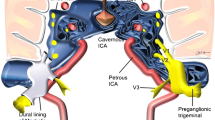Abstract
Purpose
Dilatation of the trigeminal cavum, or Meckel’s cave (MC), is usually considered a radiological sign of idiopathic intracranial hypertension. However, the normal size of the trigeminal cavum is poorly characterized. In this study, we describe the anatomy of this meningeal structure.
Methods
We dissected 18 MCs and measured the length and width of the arachnoid web and its extension along the trigeminal nerve.
Results
Arachnoid cysts were clearly attached to the ophthalmic (V1) and maxillary (V2) branches until they entered the cavernous sinus and foramen rotundum, respectively, without extension to the skull base. Arachnoid cysts were close to the mandibular branch toward the foramen ovale, with a median anteromedial extension of 2.5 [2.0–3.0] mm, lateral extension of 4.5 [3.0–6.0] mm, and posterior extension of 4.0 [3.2–6.0] mm. The trigeminal cavum arachnoid had a total width of 20.0 [17.5–25.0] mm and length of 24.5 [22.5–29.0] mm.
Conclusion
Our anatomical study revealed variable arachnoid extension, which may explain the variability in size of the trigeminal cavum in images and calls into question the value of this structure as a sign of idiopathic intracranial hypertension. The arachnoid web extends beyond the limits described previously, reaching almost double the radiological size of the cavum, particularly at the level of V3 afference of the trigeminal nerve. It is possible that strong adhesion of the arachnoid to the nerve elements prevents the formation of a true subarachnoid space that can be visualized by magnetic resonance imaging.


Similar content being viewed by others
Data availability
Dr. Le Petit had full access to all of the data used in this study and takes responsibility for the integrity and accuracy of the data analysis. Data are available upon request to the corresponding author.
Code availability
None.
References
Aaron GP, Illing E, Lambertsen Z et al (2017) Enlargement of Meckel’s cave in patients with spontaneous cerebrospinal fluid leaks. Int Forum Allergy Rhinol 7:421–424. https://doi.org/10.1002/alr.21891
Bond JD, Xu Z, Zhang H, Zhang M (2021) Meckel’s cave and somatotopy of the trigeminal ganglion. World Neurosurg 148:178–187. https://doi.org/10.1016/j.wneu.2021.01.081
Burkett JG, Ailani J (2018) An up to date review of pseudotumor cerebri syndrome. Curr Neurol Neurosci Rep 18:33. https://doi.org/10.1007/s11910-018-0839-1
Chavez-Herrera VR, Campero Á, Ballesteros-Herrera D et al (2023) Microsurgical and illustrative anatomy of the cavernous sinus, middle fossa, and Paraclival triangles: a straightforward, comprehensive review. Surg Radiol Anat 45:389–400. https://doi.org/10.1007/s00276-023-03105-y
Chen BS, Meyer BI, Saindane AM et al (2021) Prevalence of incidentally detected signs of intracranial hypertension on magnetic resonance imaging and their association with Papilledema. JAMA Neurol 78:718–725. https://doi.org/10.1001/jamaneurol.2021.0710
Degnan AJ, Levy LM (2011) Narrowing of Meckel’s cave and cavernous sinus and enlargement of the optic nerve sheath in Pseudotumor Cerebri. J Comput Assist Tomogr 35:308–312. https://doi.org/10.1097/RCT.0b013e31820d7a70
Janjua RM, Al-Mefty O, Densler DW, Shields CB (2008) Dural relationships of meckel cave and lateral wall of the cavernous sinus. Neurosurg Focus 25:E2. https://doi.org/10.3171/FOC.2008.25.12.E2
Joo W, Yoshioka F, Funaki T et al (2014) Microsurgical anatomy of the trigeminal nerve. Clin Anat 27:61–88. https://doi.org/10.1002/ca.22330
Joukal M, Klusáková I, Dubový P (2016) Direct communication of the spinal subarachnoid space with the rat dorsal root ganglia. Ann Anat 205:9–15. https://doi.org/10.1016/j.aanat.2016.01.004
Kamali A, Sullivan KC, Rahmani F et al (2020) Indentation and transverse diameter of the meckel cave: imaging markers to diagnose idiopathic intracranial hypertension. AJNR Am J Neuroradiol 41:1487–1494. https://doi.org/10.3174/ajnr.A6682
Kehrli P, Ali MM, Maillot C et al (1997) Comparative microanatomy of the lateral wall of the „cavernous sinus“ in humans and the olive baboon. Neurol Res 19:571–576. https://doi.org/10.1080/01616412.1997.11740862
Kehrli P, Maillot C, Wolff MJ (1997) Anatomy and embryology of the trigeminal nerve and its branches in the parasellar area. Neurol Res 19:57–65. https://doi.org/10.1080/01616412.1997.11740773
Marashdeh WM, Al Qaralleh MA, Hdeeb AH (2021) Quantitative parameters for diagnosis of idiopathic intracranial hypertension on brain MRI. Eur J Radiol Open 8:100371. https://doi.org/10.1016/j.ejro.2021.100371
Sabancı PA, Batay F, Civelek E et al (2011) Meckel’s cave. World Neurosurg 76:335–341. https://doi.org/10.1016/j.wneu.2011.03.037
Wang BC, Bogart B, Hillman DE, Turndorf H (1989) Subarachnoid injection–a potential complication of retrobulbar block. Anesthesiology 71:845–847. https://doi.org/10.1097/00000542-198912000-00006
Youssef S, Kim E-Y, Aziz KMA et al (2006) The subtemporal interdural approach to dumbbell-shaped trigeminal schwannomas: cadaveric prosection. Neurosurgery. https://doi.org/10.1227/01.NEU.0000227590.70254.02
Funding
None.
Author information
Authors and Affiliations
Contributions
Dominique Liguoro, Vincent Jecko and Laetitia Le Petit developed the study design. Arthur Durouchoux and Laetitia Le Petit performed anatomical dissections and prepared figures. Paul Roblot and Laetitia Le Petit wrote the main manuscript text. Gaelle Kerdiles made critical revisions. All authors reviewed the manuscript.
Corresponding author
Ethics declarations
Conflict of interest
All authors declare that they received no support from any organization for this study and have no financial relationships with any organizations that could have an interest in the submitted work.
Ethical approval
None.
Consent to participate
None.
Consent for publication
None.
Additional information
Publisher's Note
Springer Nature remains neutral with regard to jurisdictional claims in published maps and institutional affiliations.
Rights and permissions
Springer Nature or its licensor (e.g. a society or other partner) holds exclusive rights to this article under a publishing agreement with the author(s) or other rightsholder(s); author self-archiving of the accepted manuscript version of this article is solely governed by the terms of such publishing agreement and applicable law.
About this article
Cite this article
Le Petit, L., Roblot, P., Durouchoux, A. et al. How to understand an enlarged Meckel’s cave? An anatomical study. Surg Radiol Anat 45, 933–937 (2023). https://doi.org/10.1007/s00276-023-03177-w
Received:
Accepted:
Published:
Issue Date:
DOI: https://doi.org/10.1007/s00276-023-03177-w




